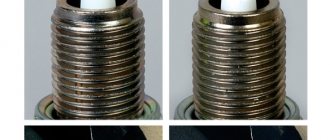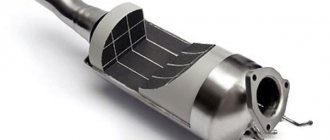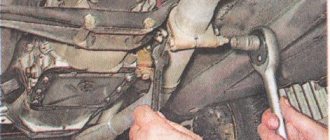08.11.2019
Modern cars are equipped with increasingly advanced exhaust systems. This is partly due to the fight for environmental safety, and partly to the desire to reduce noise while driving. To achieve minimal noise, they often resort to a method such as installing a flame arrester instead of a resonator.
The elements of the system operate under conditions of high temperatures and aggressive influence of the external environment, so they often become unusable over time. There is a trend on the market towards the unification of all exhaust system spare parts, so you can easily select a part for your car model, this also applies to flame arresters and resonators. They are available for quick installation with a minimum amount of cutting or welding.
However, it is recommended not to replace the resonator with a flame arrester yourself, but to contact a specialist.
Types of flame arresters
- Active, single layer. This type of fire arrestor uses fiberglass or mineral wool core. They are less durable than reactive ones due to the fact that the filler used quickly burns out due to high temperatures. But while it is functioning, it does its job well, for up to 2 years.
- Reactive. The work of such a product is famous for its durability. The basic principle of reducing the energy of gases is based on the damping of sound waves. They can last up to 10 years, depending on the quality of materials, manufacturing and operation.
If we take into account the design features of the exhaust system, flame arresters can also be manifold (which during installation must be removed and installed together with the exhaust manifold) and free-standing.
We will discuss in more detail the characteristics of certain types of flame arresters, the difference in price and the features of their installation in subsequent subtopics.
Why is one thing replaced by another?
The catalyst can become unusable simply by exhausting its resource. This does not happen with new cars, but if the car was bought second-hand and managed to travel 150 thousand km or more, it means that the catalyst in it is seriously worn out. And since it is impossible to clean or restore it, there is only one way out: replacing it with a flame arrester.
High mileage is not the only reason for wear of the standard catalyst. It can also become unusable due to bad fuel. Unscrupulous sellers, trying to increase the octane number of their low-quality gasoline, add additives containing lead to it. Exhaust gases from such fuel cause overheating and subsequent melting of the catalyst sections.
Finally, flame arresters are installed in cars due to the high cost of branded catalysts. This is the most popular reason, especially now, when the price of catalysts has become simply prohibitive and can vary from 50 to 250 thousand rubles.
Characteristics of flame arresters
The resonator, also known as a flame arrester, must be temperature stable and withstand heavy mechanical loads, because the speed and temperature of the exhaust generated from the fuel burned in the cylinder are very high, and accordingly they impart their energy to all components involved in the process. The name of the flame arrester speaks for itself. It directly “puts out the flames”, reduces the temperature and converts the exhaust gas streams into one smoother and cooler stream. A good, high-quality flame arrester is designed in two layers, for better absorption of vibrations during the exhaust and to dampen excess noise, and the second layer must be made of anti-corrosion, stainless material, due to the fact that the flame arrester is constantly under the aggressive influence of the atmosphere. Splashes, dirt, salt deposits, a poorly fixed muffler, loads and vibrations from a running engine and when the car is moving, all have a destructive effect on this element and therefore the design and materials must withstand all of the above.
To improve sound insulation, fillers are used: mineral or basalt. In high-quality flame arresters, this factor is also controlled by the introduction of an additional diffuser chamber. The exhaust is pre-processed in this chamber, and then further muffled by hitting the padding layer. The diffuser chamber reduces wear on the flame arrester.
Holes in the flame arrester pipe
Hello, in this article we will try to answer the question “Holes in the flame arrester pipe”. You can also consult with lawyers online for free directly on the website.
Unlike catalysts, flame arresters do not depend on the quality of the fuel mixture, and they are not affected by overheating. Therefore, time and mileage do not play a role here, and with proper care you can drive with it for a very long time. As a result, your car's maintenance costs will be significantly reduced.
Flame arrestor and catalyst. Advantages and disadvantages
A flame arrester is a kind of catalyst substitute. Both units have their pros and cons, but if we take into account the efficiency of the engine and the car, the flame arrester outperforms the catalyst on all fronts. The catalyst, due to its design, is a more complex device than a flame arrester; the materials used are rarer, which is very noticeable when you compare the prices of these parts.
The flame arrester costs significantly less and does not delay the exit of exhaust gases as much as the catalyst does. This in turn affects the power supplied by the engine to the drive. Due to certain factors, namely due to poor fuel quality or mixture formation in the combustion chamber of the cylinders, the catalyst tends to quickly fail (clog).
If the catalyst is not replaced in a timely manner, this will adversely affect the engine itself, because the exhaust process will not be carried out fully, and it can also harm people in the cabin, because the exhaust from the inability to find a way out through the muffler will smoke inside the car.
Also, when they want to achieve greater efficiency from the engine, they tune the exhaust system by replacing the catalyst with a flame arrester. This long-lasting exhaust “filter” will equalize the flow and pressure of gases leaving the engine manifold, thereby improving its technical characteristics.
The main disadvantage, which of course can cover up all the advantages of this unit, is that its filtration properties are not as good as those of the catalyst, simply put, they are not there. This means that significant harm is caused to the environment. In the Russian Federation, laws still allow the use of flame arresters as an alternative to catalysts, this is facilitated by established emission standards, but if you want to pull off such a scam in EU countries, you will not pass the scheduled technical inspection of the vehicle and will not be able to use the car.
Breakdowns and their signs
Typically, this element begins to “strange” when it travels about 150 thousand kilometers. That is, this is more likely an age-related problem with the car.
Standard and Modified
The catalyst consists of honeycombs that break down over time and do not block the release of harmful exhaust gases. The pressure in the exhaust system increases, exhaust gases go back into the engine, which leads to a significant deterioration in its performance. The engine is literally choking.
Typical signs that the catalyst is clogged are:
- The car's dynamics deteriorate significantly and noticeably;
- The engine starts with problems;
- There is a characteristic smell of sulfur in the cabin;
- The engine is unstable at idle.
If the car stops driving normally, it is advisable to immediately check the condition of this device. Alas, this cannot always be done in a garage environment, since special equipment and devices are required. But there are still two ways.
- Replace the lambda probe with a pressure gauge. Start the engine and check the pressure. If it is more than 0.5 atmospheres, things are bad.
- In the second case, you will need a remote pyrometer. If the catalyst is working normally, the temperature of the pipe before it will be higher than after it. But at the same temperature, this indicates the destruction of the honeycomb and a violation of the flame extinguishing function.
The second method allows you to obtain indirect data, so the pressure must be checked in any case. If a breakdown is detected, the catalyst must be replaced.
Article on the topic: Racks on the VAZ 2110
Replacing the device has its own characteristics depending on which engine is installed on your VAZ 2114 - eight-valve or sixteen-valve.
Installing a flame arrester instead of a catalyst
A catalyst is an element of a car's exhaust system that is responsible for cleaning exhaust gases. Simply put, the catalyst burns the car’s exhaust gases to environmental standards. Unfortunately, like most car parts, catalysts also fail. This process is often accelerated by mechanical damage and low-quality fuel. Those car enthusiasts who have not yet encountered a similar problem may be very surprised: “Why “reinvent the wheel”, isn’t it easier to replace the unusable catalyst with a new one?” they will say. Of course it’s simpler, but... There are some pitfalls here, and the main one is the huge price of a new spare part. And in some cars several catalysts are installed simultaneously. All this pushes car owners to look for alternative options, one of which is installing a flame arrester instead of a catalyst.
Possible reasons for replacing the resonator with a flame arrester
Car owners periodically face the following problems:
- Mechanical damage caused by a blow to the body or strong vibrations due to damaged rubber suspensions.
- The internal structure of the device has collapsed.
- The housing or other structural components have burnt out.
- The sound changes - with minor leaks in tightness, cutting sounds appear, with serious ones - a characteristic roar.
- The smell of exhaust gases appears in the cabin, and they also come out from under the bottom of the car.
- A rattling noise is heard from inside the case.
In all these situations, the solution may be to replace the resonator, and at this moment the owner is faced with the question - resonator or flame arrester, which is better? It is necessary to clearly understand the differences between these devices, take into account the design features of the exhaust system of a particular car, as well as the experience of replacement on similar cars.
What happens if you just remove the catalytic converter?
Often, car owners whose cars are equipped with several catalysts resort to installing flame arresters.
The question is quite relevant, given, as already mentioned, the high cost of a new part. If you don’t go deeper, it may seem that the catalyst can simply be thrown away and a regular straight pipe put in its place. We hasten to disappoint those who were counting on it. Firstly, the noise level will increase significantly, and secondly, the temperature of the exhaust gases will increase (remember that one of the functions of the catalytic converter is cooling the exhaust gases). It is the second point that is most dangerous when operating a car - prolonged operation of the exhaust system at high temperatures can damage it.
In addition, cars that meet Euro-4 standards and higher are equipped with special oxygen sensors - lambda probes. Simply dismantling them will not work, because in this case the car’s engine may begin to work unstably, and the instrument panel will constantly irritate you with error messages. The problem is eliminated by flashing the electronic control unit or using special “cheats”.
Hence we conclude: throwing away the catalyst “with all its giblets” is not the best idea. So what remains? There aren't many options:
- Install the original catalytic converter.
- Find and try to “fit” a universal catalyst to your car.
- Install a flame arrester.
Each option has a number of advantages and disadvantages, respectively. Below we will look at them in more detail. However, if your choice has already fallen on the option of installing a flame arrester instead of an unusable catalyst, you can skip the part that talks about the first two points and go straight to the last one.
Why do they replace?
I won’t tell anyone a secret if I say that the decision to replace the catalyst with a flame arrester is largely due to the economic component. That is, the car owner simply wants to save money.
Just look at the cost of this element.
If we take into account even domestic cars, the price tag will look impressive. Now imagine that your VAZ has already covered about 200-300 thousand kilometers
And here the need arises to change the catalyst. Such a purchase will cost 50-70 thousand rubles. Agree, the amount is more than serious. And compare it with the cost of a flame arrester, the price of which is several times less. Some even make it with their own hands from a piece of pipe, making many holes in it. Then the price will be completely zero.
If you decide to install such a design for yourself, do not forget about the mandatory equipment of a stronger with blende. Decoy, catalyst emulator, lambda decoy. Call it what you want. This will not change the essence.
The lambda decoy serves to correct the incoming signal from the oxygen sensor to the electronic control unit of your car. Moreover, it is necessary to install such a device if a flame arrester is installed in place of the catalyst.
Without doing this, the ECU will begin to perceive the operation of the exhaust system as problematic, and the emergency mode of operation of the internal combustion engine will begin to constantly turn on. This will result in a decrease in engine life and an increase in fuel consumption.
Similar designs, made from stronger and blende, can be installed on any car:
The use of deception should not be ignored. You already know about the consequences of such a rash decision.
Advantages and disadvantages
In conclusion, I propose to look at the pros and cons, that is, at the possible negative and positive consequences if you replace the standard catalyst with a not quite standard flame arrester.
The positive aspects include the following:
- lower costs for the purchase and installation of a stronger;
- the possibility of switching to cheaper fuel of lower grades;
- increase in engine power;
- protection of the engine from breakdowns.
It is a mistake to think that the flame arrester ruins the engine. Everything happens differently. It becomes easier for the motor to work. Problems arise only if you refuse to cheat and incorrectly configure the ECU
Therefore, it is important to contact specialists
Now as for the shortcomings. The disadvantages or consequences will be:
- the level of harmful exhaust gas will increase;
- You will definitely have to flash the ECU if snag is not used;
- The service life of the muffler will be reduced.
As you can clearly see, there will be no serious consequences if you install it correctly and use high-quality components. At many points you can even win.
It's up to you to decide whether to install a flame arrester or not, or buy a new expensive catalyst.
Thanks everyone for your attention! Subscribe, leave comments and ask relevant questions!
Watch this video on YouTube
Application of universal catalytic converter
It is a completely rational option, especially if we consider such a procedure in terms of its cost. The catalyst, including installation on the car, will cost you approximately 7,000 - 8,000 rubles. Agree - the difference is amazing. The main difference between a universal catalyst is that cheaper materials are used for its manufacture.
- affordable price;
- acceptable level of emissions;
- there is no need to reflash the control unit or install a fake oxygen sensor.
- fragility;
- complete lack of guarantees;
- low reliability indicators.
Installing a universal catalyst is a compromise between price and environmental concerns
Flame arrestor instead of catalyst
This is the decision that owners of cars with a failed catalyst make most often. This procedure is very inexpensive (about 5,000 rubles). But we have already mentioned that cars that meet Euro-4 standards and higher require additional modifications. Such work, depending on the specific car, can cost the owner another couple of thousand rubles.
The advantages of a flame arrester include:
- low cost;
- long service life;
- high reliability;
- warranty on flame arrester;
- increase in engine power.
- loss of car warranty (for new cars);
- increased levels of harmful substances in the exhaust;
- the need for additional procedures (firmware of the control unit, installation of “falseware”).
Removing and installing the resonator
Many motorists are interested in a natural question - how to remove the resonator ? The answer to this question will vary depending on the brand of car. However, in general, the algorithm is simple and will be approximately as follows:
- it is necessary to disconnect the resonator pipes at the points of their connection with the exhaust gas removal system (front, on the engine or catalyst side, and at the rear, on the muffler side);
- remove the resonator from its suspensions, with the help of which it is attached to the bottom of the car;
- dismantle the resonator with its pipes.
How to replace a Renault Logan resonator
Installing a new device is done in the reverse order. When removing the resonator, it is important not to damage the O-rings that connect its pipes to the rest of the exhaust system.
How to make a flame arrester yourself
In some situations, it is quite difficult to find a ready-made flame arrester, so many car owners have to take up the tool and make this element on their own. There is nothing complicated about making a flame arrester instead of a catalyst with your own hands; we will prove this with the following example:
- To make a flame arrester we will need two pieces of iron pipe. One of the pipes should match the diameter of the exhaust pipe of the car, and the second should have a larger diameter (this will be the flame arrester body). In addition, we will stock up on regular kitchen steel wool.
- We drill holes with a diameter of about 3 mm in the inner pipe over its entire area. Next, we insert it inside the housing (pipes with a large diameter). We brew one side.
- Place a washer approximately in the middle of the inner pipe. The washer should have a hole equal to ⅔ the diameter of the inner pipe.
- In the next step, we push metal wool between the two pipes (as if putting them on the inner one). Pack tightly. You need to fill the entire space from top to bottom; in the example given, 26 washcloths were needed. We are almost finished - all that remains is to cut the free edge of the pipe (body), bend it and scald it.
That's probably all. The replacement of the catalyst with a flame arrester is completed by removing the catalytic converter itself from the exhaust system and installing in its place the result of your efforts - a self-made flame arrester.
Are you still awake? Well then, let's move on.
For example, for a 1.6 liter engine, exhaust pipes with a diameter of 3.8-5 cm are installed. For a 2.5 liter engine, structures measuring 5 - 6.4 cm are sufficient. For larger engines, structures measuring 7.6 cm can be installed. If Engine capacity above 2.5 liters, it is better to spend money on a dual gas exhaust system. As is obvious, the higher the engine displacement, the larger the pipe size should be.
Thus, the flame arrester and catalyst are designed to solve different problems, although they are located in the same place.
Each of these options has certain advantages and disadvantages, which we will consider. If you are determined to replace the catalyst with a flame arrester, you can immediately move on to the third option.
Making a flame arrester with your own hands
Due to the tightening of International environmental requirements, a mandatory condition for the operation of vehicles is the installation of catalytic exhaust gas converters. But, this element belongs to the category of expensive, since the design of its filter unit contains alloys of precious metals, so if it fails, it is best to install a flame arrester instead of a catalyst with your own hands. The exhaust gas converter is very demanding on the quality of the fuel; during the operation of the vehicle, its cells become covered with an abundant layer of soot deposits, which reduce the throughput of the device and cause a decrease in engine power.
Important! Any catalyst is very sensitive to mechanical stress; even minor damage to its honeycombs can completely damage the part. It is quite problematic to restore the original functionality of the element, so most experienced auto mechanics suggest making a flame arrester from a used catalyst.
When the neutralizer honeycombs are contaminated, there is a significant increase in pressure inside the exhaust system, which causes a decrease in the acceleration dynamics of the vehicle and a significant increase in fuel consumption. The complexity of the problem lies in the fact that the exhaust system of most vehicle models contains several of these elements.
Main functions and purpose
Even the best quality catalyst can fail sooner or later. It is one of the important components of the exhaust system, so the question becomes: how and with what to replace it? The easiest way is to purchase a new catalyst, but original products are quite expensive, since precious metals are used in this spare part.
An alternative solution could be a flame arrester, which is popularly called a “stronger”. Its installation will not only solve the problem of the catalyst, but is also a popular tuning element. Functionally, this part plays the role of a catalytic converter and resonator. Structurally, it is even simpler, although it does the work of primary processing of exhaust gases.
Why you need a stronger (flame arrester) can be understood using the following example. It reduces the speed of exhaust gases and reduces the noise that occurs due to engine operation. Unlike a catalytic converter, its operation does not oxidize the exhaust gases. Moreover, the design of the flame arrester is simpler, as mentioned above. Because of this, the back resistance of the exhaust gases is reduced while the power of the power unit and dynamics are increased. In addition, such tuning is inexpensive and universal.
What happens if the catalyst is completely removed from the car?
This issue is almost a priority for most vehicle owners. Many people believe that the solution to all problems will be to install a direct flow instead of a used converter. But, in addition to the fact that this will lead to a significant increase in noise, the exhaust gases will constantly be at a high temperature, and this negatively affects the operation of other components of the car.
On many modern cars, a special sensor is installed along with the catalytic converter, the removal of which will certainly cause an error signal to appear. Before dismantling the neutralizer and sensor, it is best to consult with a specialist who will help in solving this problem, since this will require an integrated approach.
Is it possible to simply delete a block?
It is obvious that by simply removing the multifunctional segment of the exhaust system, the uneven hot flow of gases will have a destructive effect on the remaining sections of the system, the design and materials of which do not provide for such loads. This can lead to their premature failure and subsequent frequent replacement. If the general structure of the exhaust system is damaged, the exhaust sound will change and become louder, and vibration may appear and be transmitted to the car body.
On car enthusiast forums, the topic of replacing the catalyst is very popular. And, despite the variety of car brands discussed, common issues and solutions can be identified. Reviews from car owners include complaints about an increase in noise and the appearance of vibrations after removing the catalyst. An unpleasant “hum” appears in the engine’s operation, and the rattling of the internal parts of a broken converter can be replaced by the ringing voice of the entire system. Reviews are often full of warnings about the irresponsible work of would-be craftsmen who replace part of the system with a catalyst with a straight section of pipe, after which the subsequent elements burn out - the resonator or muffler. The issue of replacement becomes especially relevant when the catalytic unit is located inside the cast iron pipe of the exhaust manifold.
How to solve a problem?
The issue with a failed catalyst can be resolved in one of the following ways:
- Purchase and install an expensive original neutralizer.
- Use a universal part.
- Make a flame arrester with your own hands from a catalyst and install it on a car.
Note that each of the listed options has both its pros and cons. Let's describe in more detail the last item on the list - making your own flame arrester from a used exhaust gas neutralizer.
Distinctive features of the flame arrester
In the exhaust system of vehicles, this element has the following design: a durable double cylindrical body made of stainless steel, divided inside into special chambers. Thanks to this device, the flame arrester effectively suppresses vibration, and the presence of direct flow does not trap exhaust gases in the system, as with a neutralizer installed. In addition, the resonator on a car with an installed flame arrester begins to operate more steadily and steadily due to the redistribution of the primary flow of exhaust gases. Most motorists replace the resonator with a stronger, which prevents the formation of back pressure, which negatively affects the operation of the power unit, causing a sharp decrease in its power.
Despite the fact that a vehicle can function perfectly without a stronger, if it has been decided to make a flame arrester and install it in the exhaust system, it is still advisable to use this element.
Metal or ceramics?
Another important aspect is the metal or ceramic catalyst. The base of the honeycomb (on which noble metals are then sprayed) can be either metal or ceramic.
Now more and more manufacturers are switching to ceramic options and moving away from metal ones. This is also a big problem.
Metal neutralizer: There are many advantages here - this option is much more reliable, it could last for a very, very long time. It is practically unafraid of physical shocks, temperature changes, exposure to water, the pressure of exhaust gases, and can more easily withstand a malfunction of the fuel supply system.
However, the disadvantages: - it does not clean the exhaust so effectively, and most likely it will not pass the EURO 6 standard, because the honeycombs cannot be made thin to increase the coverage area (heating is also slower, and the catalyst begins to work only at a temperature of about 300 degrees Celcius). Also, its production is more expensive than the ceramic version. Therefore, many manufacturers are now starting to abandon them
Ceramic base. Pros: – cheap, which is good for the manufacturer. It cleans the exhaust better (due to the fact that the honeycombs can be made smaller), warms up faster (starts working faster). This is where the positive aspects end.
Negative points: - more fragile design, it is more easily destroyed (service life may be minimal). And from the flow of exhaust gases (it happens that the exhaust manifold is made incorrectly), from temperature changes (when it cools sharply, for example, water gets in), from improper fuel supply, and even from the fuel itself. Another global disadvantage is that it crumbles and turns into ceramic sand, which can be sucked into the engine block (and most likely, scuffs will form).
BUT the scourge of modern cars is that ceramics are now used on many cars, from KIA, HYENDAI, TOYOTA, NISSAN to Chinese manufacturers.
Why is it better to make a flame arrester yourself rather than buy a ready-made one?
The market for automobile spare parts and components is replete with flame arresters of various models. But despite this, selecting an element for a specific car is almost impossible. The whole point is that the dimensions of the flame arrester must completely correspond to the dimensions of the neutralizer removed from the system, otherwise the entire exhaust tract will have to be completely rebuilt. Exclusively for this reason, it is advisable to independently manufacture a flame arrester, since only in this case will it be possible to correctly select the dimensions and characteristics of the part.
How to make your own flame arrester from a catalyst?
To make a flame arrester you will need:
- welding machine;
- two metal pipes, one of them should be of a smaller diameter;
- metal brushes-scrapers for washing dishes;
- old exhaust gas converter.
Our homemade flame arrester will be located in the catalytic converter housing, so it will need to be cut in half and the non-working honeycomb removed. The diameter of one of the pipes must completely correspond to the diameter of the exhaust tract. The second pipe should be slightly larger in diameter so that it completely covers the first, and metal scraper brushes can be pressed into the gap between them. In this case, a larger diameter pipe must be placed in the body of the non-working catalyst.
In a pipe of smaller diameter (which will connect to the exhaust tract of the car), it is necessary to drill small holes. Next, we insert the smaller pipe into the larger one, having previously centered them and welded one of the edges. Now you need to fill all the space between the pipes with metal scrapers for washing dishes. They need to be compacted tightly, then bend the edges of the pipe around the circumference and completely scald them. We place the resulting structure in the catalyst body, assemble it and weld it at the cut points.
The resulting flame arrester can be welded into the exhaust system. But that is not all. To ensure correct operation of the exhaust system and power unit, and to remove the Check Engine error, it is necessary to install a special blende.
What and how to replace the oxygen sensor?
If the catalytic converter malfunctions in vehicles, a corresponding signal appears on the instrument panel, which is transmitted to the control unit by a special oxygen sensor, or lambda probe. In order for all systems to work correctly and the error signal no longer occurs, it is necessary to use the so-called “decoy”. The most common mechanical type of such devices.
Note that the operation of the “falsehoods” is based on the principle of limiting the volume of exhaust gases, which is constantly monitored using an appropriate sensor. Thanks to this, there is significantly more oxygen in the car’s exhaust, and the system can function correctly.
The manufacturing process of such a part will not be difficult. It is enough to install a so-called spacer at the location of the lambda probe and catalytic converter, and move the second lambda slightly away from the catalyst. The exhaust gases that will pass through the spacer lose the concentration of harmful impurities and substances in them, and the oxygen sensor moved from the converter will begin to record the normal oxygen concentration and issue a corresponding signal.
It turns out that making a reliable and functional flame arrester yourself and installing it instead of an expensive catalyst is not so difficult. Moreover, such a homemade element will not cause any harm not only to the exhaust tract and power unit of vehicles, but also to the environment.











